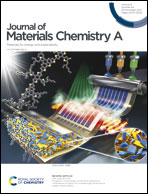Synthesis of vanadium based binary oxides with a yolk–shell structure and their derived electrocatalysts†
Abstract
The design and synthesis of non-precious metal composite catalysts with a yolk–shell structure and diverse compositions are challenges in materials science for energy conversion. In this work, we established a facile method to synthesize a series of transition metal oxides with yolk–shell structures (YS structures) by combination of Ostwald ripening and the Kirkendall effect. VO(acac)2 and other transition metal chlorides were chosen deliberately as the interfusion couple for the development of the YS structure. Among all transition binary metal oxides, WVOx has a distinct YS structure which can be preserved well in the following sulfurization. The resultant WS2–V2O3 and WS2–V3S4 yolk–shell spheres were certified to be competitive catalyst candidates for the HER and ORR respectively, due to compositional tuning and the YS structures. The fabricated WS2–V2O3 catalyst exhibits excellent HER electrocatalytic activity with a Tafel slope of 87 mV dec−1 and a small overpotential of 89 mV to reach 10 mA cm−2. The ORR catalyst WS2–V3S4 shows remarkable activity with a positive onset potential of 0.95 V and lower Tafel slope of 51 mV dec−1.



 Please wait while we load your content...
Please wait while we load your content...